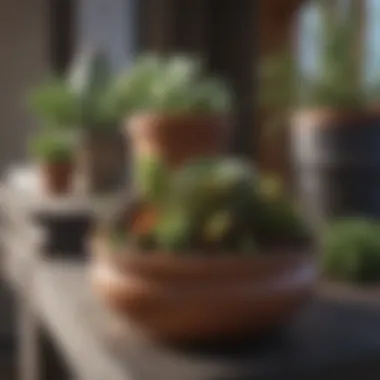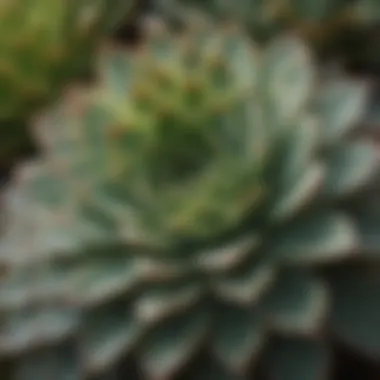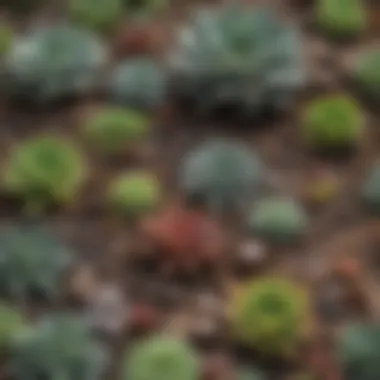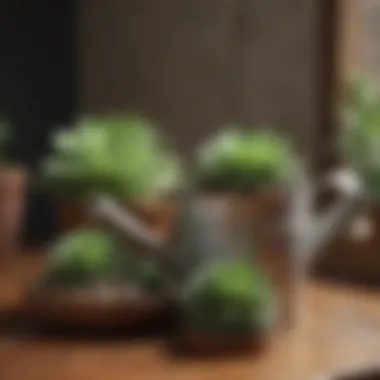Comprehensive Guide to Indoor Succulent Care


Intro
Indoor succulents are becoming increasingly popular for individuals seeking to enhance their living spaces. These plants not only serve as aesthetic additions but also improve indoor air quality. Understanding the specific care requirements for succulents is crucial to their success. This guide will elucidate the intricate details of succulent care, covering vital topics such as light requirements, soil composition, watering strategies, pest management, and troubleshooting common issues. By integrating this knowledge, one can effortlessly cultivate vibrant succulents indoors.
Home Features
Optimal Growing Conditions
Creating an ideal environment for succulents is essential. These plants thrive in bright, indirect sunlight. A south or west-facing window is often the best location. Too little light can cause them to stretch, while too much direct light can scorch their leaves. Therefore, assessing the light exposure in your home is vital for successful growth.
Essential Soil Selection
Succulents require well-draining soil to prevent root rot. Regular potting soil holds too much moisture. It is advisable to use a specially formulated cactus or succulent mix. Alternatively, one can create a custom blend using potting soil, perlite, and coarse sand to improve drainage.
Proper Watering Techniques
Watering is a critical aspect of succulent care. These plants store water in their leaves and stems, making overwatering a significant risk. It is better to water deeply but infrequently. Checking the soil's dryness before watering is recommended. Generally, a good rule is to water when the top inch of soil feels dry.
"Proper watering and the right soil combination will be the foundation for successful succulent cultivation."
Pest Management
If pests infest your indoor succulents, it can lead to serious health problems for the plants. Common pests include mealybugs, spider mites, and aphids. Regularly inspecting your plants can help identify these issues early. If pests are found, using a mixture of water and dish soap for treatment is effective. Rinse the leaves thoroughly afterward to remove any residue.
Common Challenges
There are several challenges succulent owners face. One of the most notable is the balance between light and water. Providing too much or too little of either can lead to various problems such as leaf drop or discoloration. Noticing changes in the plant's appearance is essential.
Additionally, pests can be a recurrent issue. Remaining vigilant and maintaining proper care practices will mitigate these risks significantly. By following the tips outlined in this guide, the chances of overcoming these hurdles increase markedly.
Preface to Indoor Succulents
Indoor succulents have emerged as more than just a trend; they represent a significant shift in how we engage with our living spaces. Understanding the value of integrating succulents into indoor environments is crucial, as these plants bring not only aesthetic appeal but also practical benefits. They serve as natural air purifiers and can improve overall air quality. Additionally, succulents require minimal maintenance, making them suitable for both novice and experienced plant owners alike.
One important aspect to consider is their adaptability. Succulents can thrive in various indoor conditions, from bright windowsills to dimly lit corners, as long as their specific needs are met. This versatility allows individuals to express their personal style through diverse plant selections without being overly concerned about demanding care routines.
Moreover, succulents epitomize resilience. They have evolved to store water in their leaves, stems, and roots, which means they can tolerate periods of neglect compared to other houseplants. As indoor gardening gains popularity, understanding the unique characteristics and requirements of succulents equips enthusiasts to create thriving indoor landscapes.
To truly appreciate indoor succulents, one must also acknowledge their diverse forms and colors. From the rosette shape of an Echeveria to the spiky allure of an Aloe Vera, these plants can enrich any interior design. Their varying colors, from deep greens to vivid reds and purples, offer countless possibilities for creative arrangements and displays.
In summary, indoor succulents represent a harmonious blend of beauty, functionality, and ease of care. Delving into their unique biology, growing preferences, and aesthetic contributions is essential for anyone looking to enhance their indoor environment with these remarkable plants.
Understanding Succulent Biology
Understanding the biology of succulents is crucial for anyone looking to care for these unique plants. Succulents are distinctive because of their ability to store water in their leaves, stems, or roots. This adaptation enables them to thrive in arid environments, making them popular choices for indoor gardening. Knowledge of their biological traits allows caretakers to provide the best conditions for their growth, enhancing both health and aesthetics. By recognizing the inherent characteristics of succulents, owners can avoid common pitfalls and ensure their plants flourish.
Unique Characteristics of Succulents
Succulents exhibit several unique characteristics. These traits include their thick, fleshy tissues, which function as reservoirs for water. This feature makes them resilient in dry conditions. Additionally, succulents have specialized photosynthesis, known as CAM (Crassulacean Acid Metabolism), which allows them to use water efficiently. This adaptation enables them to open their stomata mainly at night, reducing water loss. Understanding these traits is essential for effective care practices, as it informs decisions about watering, light exposure, and soil selection.
Varieties of Indoor Succulents
Indoor succulents come in an array of species, each with its unique traits and needs. Understanding the different varieties is important for those seeking to create a diverse and thriving indoor garden.
Popular Succulent Species
Popular succulent species include the Echeveria, Aloe Vera, and Haworthia. Echeveria, with its rosette shape and vibrant colors, is a favored choice for indoor decoration due to its aesthetic appeal. Aloe Vera is not only beautiful but also offers medicinal properties, making it a practical option. Haworthia is known for its hardiness and ability to adapt to lower light conditions. These species are beneficial for beginners since they are generally easy to care for and forgiving of minor mistakes. However, potential challenges may arise if the specific lighting or soil conditions are not met.
Rare Succulent Varieties
Rare succulent varieties, such as the Lithops and Adenium, add a unique touch to any collection. Lithops, or living stones, resemble pebbles, making them intriguing for visual aesthetics. They require very specific care conditions, resulting in fewer enthusiasts being able to cultivate them successfully, thus increasing their rarity. The Adenium, known as the desert rose, attracts attention with its striking blooms. However, its needs for well-draining soil and regular watering must be carefully managed. Cultivating rare species can be rewarding but requires a deeper understanding of their specific care requirements.
"A comprehensive understanding of succulent biology allows enthusiasts to better appreciate and care for these resilient plants."
Ideal Growing Conditions for Indoor Succulents
Creating the right environment is essential for indoor succulents. Such plants, despite their hardiness, have specific needs that can impact their growth and overall health. Understanding ideal growing conditions can enhance their appearance and longevity, leading to a nourished indoor garden.
Light Requirements
Light is pivotal in the life of succulents. They require sufficient exposure to ensure proper growth and vibrant appearance.
Natural Light vs. Artificial Light
Natural light is often preferred as it mimics the plant's native environment. Succulents thrive under direct sunlight. This type of light encourages healthy growth and vibrant colors, offering a natural aesthetic to any indoor space. However, not all homes have abundant natural light.
On the other hand, artificial light presents a viable alternative. Grow lights can be adjusted for intensity and duration, helping plants receive adequate light. The main characteristic of artificial light is its adaptability; it allows for year-round growth, independent of seasons. Yet, it may not replicate the full spectrum like natural sunlight.
In essence, choose based on your environment. Indoor spaces with ample sunlight should prioritize natural lighting. If natural options are limited, reliable grow lights serve as effective alternatives.


Signs of Insufficient Light
Recognizing inadequate light levels is equally important. Leaf discoloration, stretching, and slow growth are common indicators that plants are not receiving enough light. Specifically, yellowing leaves may suggest a lack of sunlight, whereas elongated stems indicate a search for better exposure.
These signs provide critical information for care routines. Addressing light needs immediately can save plants from further stress or decline. Owners should observe and adjust the light exposure as needed.
Temperature and Humidity
Maintaining proper temperature and humidity levels is another fundamental aspect. Both factors play a role in how succulents take in nutrients and moisture.
Optimal Temperature Ranges
Indoor succulents generally flourish in temperatures between 60°F to 80°F. This range ensures metabolic processes function effectively. Extreme temperatures can lead to stress, causing wilting in some varieties.
One key feature of maintaining these optimal ranges is consistency. Fluctuations in temperature can confuse a plant's growth cycles. For better results, avoid placing succulents near heating vents or drafty windows. Stability in temperature promotes overall health.
Humidity Considerations
Succulents are adapted for arid environments, thriving in lower humidity levels. Ideal indoor humidity is usually around 30% to 50%. High humidity can increase the risk of pests and diseases.
Many plant owners overlook humidity levels, thinking they are not significant. However, understanding this aspect can drastically influence an indoor garden's success. Using a hygrometer can help monitor levels and ensure they align with succulents' preferences. If humidity rises excessively, employing a dehumidifier might become necessary.
It's essential to evaluate both light and temperature conditions concurrently. Addressing these factors holistically can lead to thriving succulents.
By ensuring ideal growing conditions, succulent owners can enjoy healthy plants that not only beautify their space but also bring satisfaction in their care journey.
Soil Selection for Succulents
Soil selection plays a critical role in the successful care of indoor succulents. Unlike typical houseplants, succulents require specific soil characteristics that mimic their natural arid environments. The right soil can enhance drainage, prevent root rot, and provide essential nutrients, making it essential for the health of these resilient plants.
Choosing the appropriate soil mix supports healthy growth, ensuring that overwatering is minimized and that the plant has the right foundation for its roots to thrive. This section will delve into the specific elements of ideal soil selection, comparing commercial potting mixes with custom options, and highlighting their respective benefits and considerations.
Characteristics of Ideal Soil
Drainage Properties
Drainage properties are of utmost importance when selecting soil for succulents. These plants thrive in a well-draining medium that prevents water from pooling around the roots. The ideal soil must allow excess water to flow freely, which helps to avoid conditions that can lead to root rot.
A highly beneficial feature of good drainage is that it reduces the risk of overwatering. Selecting soil that includes components like sand or perlite is popular among succulent enthusiasts due to its porous nature. This aspect not only aids drainage but also improves aeration, allowing roots to breathe. However, care must be taken to ensure that the soil still holds enough moisture to meet the succulents' needs without becoming soggy.
Nutrient Composition
Nutrient composition is another crucial factor when it comes to soil selection for succulents. While succulents are not heavy feeders, they require a balanced supply of nutrients to support their growth. Key ingredients in succulent soil mixes often include organic matter, which provides essential minerals and encourages beneficial microbial activity.
A noteworthy characteristic of nutrient composition is that it can vary significantly between commercial mixes and custom blends. For those using pre-mixed options, they typically highlight a formulated balance conducive to succulent health. However, with custom mixes, there is flexibility to adjust nutrient levels based on specific succulent varieties. Striking the right balance in nutrient composition helps to promote vibrant growth and resilience.
Commercial Potting Mixes
Benefits of Pre-Mixed Options
Pre-mixed potting soils designed for succulents come with distinct advantages. They are readily available and tailored specifically for succulent care, often containing the right combination of drainage elements and nutrients. Many gardeners prefer these options due to their convenience and reliability.
One key benefit of using pre-mixed potting options is consistency. You are assured of receiving a blend that has been tested and optimized for succulent growth. This reliability allows enthusiasts to focus more on care practices instead of soil formulation. However, one should still be mindful of the specific requirements of their plants, as not all commercial mixes will suit every type of succulent.
Considerations for Custom Mixes
Creating a custom potting mix allows for a high degree of personalization, catering to the unique needs of various succulent species. This option is particularly advantageous for experienced gardeners who wish to fine-tune soil ingredients. A custom mix can offer better drainage properties or nutrient levels that are otherwise missed in pre-mixed soils.
The key characteristic here is adaptability; you can adjust your mix based on specific growth conditions or particular challenges faced with certain succulents. An advantage of custom blends is the ability to experiment with different ratios of ingredients until you find what works best for your indoor garden. However, it requires a greater level of knowledge and effort in understanding the components needed for optimal growth.
Watering Techniques for Succulents
Watering is a vital aspect of succulent care. The right technique ensures these resilient plants thrive indoors. Excess or insufficient moisture can lead to detrimental effects on their health. Proper watering techniques not only maintain the plant's aesthetic appeal but also enhance its longevity.
Understanding Succulent Water Needs
Succulents, being drought-tolerant plants, have unique watering requirements. They store water in their leaves, stems, or roots. Therefore, their water needs differ significantly from traditional houseplants.
Key points to consider include:
- Watering Frequency: Typically, it is more crucial to water less frequently rather than more often. Depending on environmental conditions, a good rule is to water every 2 to 3 weeks in the growing season.
- Soil Moisture: Always assess the soil moisture before watering. It is best to use a finger test, inserting a finger about an inch into the soil. If it's dry, then the plant likely needs water, if it’s still moist, wait longer.
- Seasonal Adjustments: Adjust your watering habits according to the season. In winter, succulents enter a dormancy period and require even less water.
Like any responsible plant owner, understanding these essentials is key in developing a sustainable watering routine.
Signs of Overwatering and Underwatering
Identifying the signs of improper watering is crucial for maintaining the health of succulents.
Leaf Texture Changes
One can tell a lot about a succulent’s well-being from its leaf texture. If the leaves become mushy or wrinkled, this indicates a problem with either overwatering or underwatering. Leaves that are preserved in a firm state suggest a well-hydrated plant.


- Mushy Leaves: This often indicates overwatering. The excess moisture can cause the cells to burst, leading to a soft texture.
- Wrinkled Leaves: This signifies the plant is not receiving enough water. The cells shrivel, making the leaves appear leathery and shriveled.
Maintaining the ideal leaf texture contributes to the plant's overall health and aesthetic.
Root Rot Identification
Root rot is one of the most serious issues faced by succulent owners. This condition occurs when the roots sit in waterlogged soil for an extended period.
- Symptoms of Root Rot: Yellowing leaves can be a primary indicator. Additionally, if the base of the stem appears mushy, that could signify root health problems.
- Importance of Addressing Root Rot: Identifying and addressing root rot early can save your plant. Removing affected roots and repotting into fresh, dry soil increases the chances of recovery.
In summary, understanding and implementing appropriate watering techniques is essential for successful indoor succulent care. Observing the signs of stress, whether from too much or too little water, will guide you in nurturing these remarkable plants effectively.
"Water management is as important as light, temperature and soil when it comes to maintaining a healthy indoor succulent."
By remaining attentive to these needs, you pave the way for a thriving indoor sanctuary filled with living art.
Fertilization Practices for Indoor Succulents
Fertilization is a critical aspect of indoor succulent care. While succulents are known for their resilience, they still require certain nutrients to thrive. A well-thought-out fertilization plan can enhance growth, promote vibrant colors, and ensure overall health. Understanding when and how to fertilize, as well as the types of fertilizers to use, can significantly impact the success of these unique plants. Neglecting to provide sufficient nutrients can lead to stunted growth or poor aesthetics.
When to Fertilize
The timing of fertilization is crucial for indoor succulents. Generally, the best time to fertilize is during the growing season, which is typically in the spring and summer months. This is when the plants are actively developing and can effectively utilize the added nutrients.
Indicators for Fertilization:
- Healthy growth in the previous seasons
- New leaf development
- Signs of nutrient deficiency, such as yellowing leaves
It is wise to avoid fertilizing during the dormant period, usually in the fall and winter. During this time, succulents are not actively growing, and fertilizing can result in nutrient accumulation that harms the plants.
Best Types of Fertilizers
When selecting fertilizers for indoor succulents, it is essential to consider their specific needs. Various types of fertilizers cater to the requirements of succulents, and understanding their differences can help in making an informed choice.
Liquid vs. Granular Fertilizers
Liquid fertilizers are often seen as a beneficial option for succulents. They can be applied directly to the soil or as a foliar spray. One key characteristic of liquid fertilizers is their quick absorption. This allows the plants to utilize nutrients immediately, which is advantageous during the primary growing season.
Granular fertilizers, on the other hand, offer a slower release of nutrients over time. This can be beneficial because it reduces the risk of over-fertilization while providing consistent nourishment. However, one should carefully monitor the amount applied, as too much can lead to salt buildup in the soil.
Both types have their unique advantages and disadvantages:
- Liquid Fertilizers: Quick nutrient uptake, easy application, potential for over-fertilization if not monitored.
- Granular Fertilizers: Steady nutrient release, less frequent application, risk of salt accumulation if overused.
Organic vs. Synthetic Options
When deciding on fertilizers, choosing between organic and synthetic options is another significant consideration. Organic fertilizers are derived from natural sources such as compost or manure. These options are popular among many for their ability to enrich the soil and promote microbial health, leading to a more balanced growing environment for succulents.
Synthetic fertilizers, however, provide a concentrated dose of essential nutrients and are often more quickly available for plant uptake. Their efficiency is a key characteristic, particularly when immediate results are desired. However, synthetic options can lead to soil degradation if used excessively.
Each type has its features and implications for succulent care:
- Organic Fertilizers: Gentle on plants and soil health, slow nutrient release, can be more labor-intensive to apply.
- Synthetic Fertilizers: Fast-acting, precise nutrient delivery, higher risk of soil imbalance if used long-term.
"Understanding the type of fertilizer to use and the timing can be pivotal for maintaining the vitality of indoor succulents."
Pest Management in Succulent Care
Pest management is a critical aspect of ensuring the health and longevity of indoor succulents. These plants, while resilient, are not immune to various pests that can undermine their well-being. Understanding the significance of pest management can enhance the overall aesthetic and health of your succulent collection. By developing effective control strategies, you can prevent infestations and mitigate damage, ensuring sunlight and attention yield beautiful results.
Common Pests Affecting Succulents
Indoor succulents can fall prey to several common pests. These include:
- Mealybugs: Small, white, cotton-like insects that feed on plant sap.
- Aphids: Tiny, soft-bodied insects that can cluster on succulent leaves.
- Spider Mites: Microscopic pests that produce fine webs and cause leaf discoloration.
- Fungus Gnats: Small flies whose larvae can damage the roots.
Identifying these pests early is crucial. Regular inspection of your plants can help in obtaining effective control measures.
Preventive Measures and Treatments
Preventive care forms the backbone of pest management. Ensuring proper care of succulents not only strengthens their immunity but also minimizes the risk of pest infestations. Here are approaches for prevention and treatment of pests:
Chemical vs. Non-Chemical Solutions
Chemical solutions often offer immediate results when dealing with pests. Common chemical treatments include insecticidal soaps and neem oil. These solutions are popular due to their effectiveness against a broad range of pests.
However, they come with drawbacks, such as potential harm to beneficial insects if applied recklessly. Non-chemical alternatives, on the other hand, include diatomaceous earth and essential oils. They are less harmful to the ecosystem and provide a great choice for those wanting a more holistic approach.
The ideal choice depends on the infestation level and personal preferences for handling pests.


Regular Monitoring Techniques
Regular monitoring is key to preventing infestations. This means consistently checking your plants for signs of pests. Use a magnifying glass or smartphone camera to observe details that might go unnoticed by the naked eye.
Monitoring allows for early detection of any issues. Catching problems before they escalate can save plants from significant damage. Set a schedule for inspections, perhaps every two to four weeks.
Regularity in monitoring not only protects your succulents but establishes healthy gardening habits overall.
Repotting Succulents
Repotting is a critical aspect of indoor succulent care that ensures the plants thrive in their environment. Over time, succulents can outgrow their pots or develop unhealthy root systems. Therefore, understanding when and how to repot is vital for the health of these resilient plants. Successful repotting can lead to better growth, improved appearance, and prolonged life of the plant.
When to Repot
Indicators for Repotting
A key element in deciding to repot a succulent is recognizing the indicators that signal it is time for this crucial step. Common signs include roots protruding from the drainage holes, soil that dries out too quickly, or a noticeable reduction in growth.
These characteristics are indicators of either a crowded root system or depleted soil nutrients, both of which can hinder plant health. For instance, if a succulent leans significantly in one direction, it may signify that the plant has become top-heavy due to a lack of space. When such indicators are observed, it is typically a strong indication that repotting is necessary.
Seasonal Considerations
Another important aspect of repotting is the timing within the seasons. Ideally, succulents should be repotted during spring or early summer when their growth is at its peak. This aligns with their natural growth cycle, allowing them to adjust more easily to new soil and pot conditions.
Choosing this timing enhances the chances of successful adaptation. Repotting during dormancy, like winter, can set back growth significantly and risk the health of the succulent. Thus, considering the seasons plays a crucial role in the overall wellbeing of indoor succulents.
Steps for Successful Repotting
Choosing the Right Pot
The choice of pot is a fundamental aspect of successful repotting. A pot that is too small will restrict growth, while one that is excessively large can hold excess moisture, leading to root rot. Ideally, select a pot that is slightly larger than the previous one, which allows for room to grow without causing water retention issues.
Strong drainage holes are a must in pots for succulents, as this prevents excess moisture buildup and promotes healthy root systems. Therefore, ensuring that the pot is appropriate in size and material is pivotal for the plant's health.
Transplanting Techniques
The actual technique of transplanting is also significant. Carefully removing the succulent from its existing pot reduces the risk of damage to its roots. It is essential to handle the plant by its base, avoiding unnecessary stress on the root system.
After removal, gently loosen any tightly bound roots and clean the old soil away from the root ball. Positioning the plant at the same depth as it was before is crucial to ensure it doesn’t suffer from transplant shock. Each of these techniques contributes to the successful establishment of the succulent in its new environment, promoting vitality and growth.
Common Challenges and Solutions
In the realm of indoor succulent cultivation, various obstacles may arise, impacting the vitality and aesthetics of these resilient plants. Recognizing these challenges is key to sustained indoor gardening success. Understanding the common issues helps in mitigating risks and fostering a thriving greenery environment. This is crucial for ensuring succulents both survive and thrive in their indoor settings.
Leaf Discoloration
Causes of Color Change
Leaf discoloration in succulents can indicate underlying issues that may affect the plant’s health. One of the primary reasons for such color changes is exposure to inappropriate light levels. Overexposure to sunlight can cause leaves to scorch, leading to browning or a bleached appearance. Similarly, insufficient light can lead to a pale or leggy look, as the plant stretches towards available light.
Another factor contributing to color change includes nutrient deficiencies. Lack of essential nutrients can cause yellowing leaves, particularly nitrogen. Identifying these causes early is crucial, as it allows for timely intervention, ensuring that plants can bounce back without severe detriment.
Remedies for Leaf Issues
Addressing leaf discoloration requires tailored solutions based on the underlying causes. If the issue stems from light discrepancies, adjusting the position of the succulent to provide more adequate sunlight or utilizing artificial grow lights becomes imperative.
In cases related to nutrient deficiencies, a balanced fertilizer may rejuvenate the plant's health. Regular monitoring of water types and default soil mixes can help ensure nutrient availability, thus supporting the overall well-being of the succulent. However, caution is paramount; over-fertilization can lead to further complications, highlighting the need for balanced care.
Growth Stagnation
Identifying Stagnation Causes
Growth stagnation presents a significant challenge for succulent owners, suggesting potential issues in care or environment. One major factor contributing to stagnation is improper watering practices. Both overwatering and underwatering can hinder growth, leaving the plant in a state of dormancy. Soil composition also plays a role; compacted or poorly draining soil can stress roots, obstructing their growth potential.
Moreover, extreme temperatures or fluctuating conditions can impede growth. Succulents thrive at consistent temperatures, and any drastic changes can cause a halt in their development. Understanding these factors can assist in diagnosing the problem, fostering better decisions toward resolution.
Enhancing Growth Conditions
Improving the conditions for growth is essential for reviving stagnating succulents. Optimizing light exposure by ensuring plants receive adequate natural or artificial light is crucial for photosynthesis and growth stimulation. Establishing a consistent watering schedule that aligns with seasonal changes promotes healthy growth.
Additionally, ensuring well-draining soil with appropriate aeration can help maximize root health. A mix of potting soil designed for cacti and succulents can provide the right blend of drainage and nutrition. By implementing these strategies, owners can often witness significant improvements in their plants' growth dynamics.
Ending
The conclusion of this guide to indoor succulent care holds significant importance for anyone looking to cultivate these resilient plants. It serves as the final synthesis of all the information provided throughout the article. By summarizing the critical points, it reinforces the knowledge that helps in successful care and maintenance of succulents.
Understanding the key elements of succulent care is essential. This includes optimal light and water conditions, appropriate soil types, and recognizing pest threats. All these factors contribute to the overall health and aesthetic value of succulents as indoor plants.
One of the benefits of understanding succulent care is increased confidence in plant ownership. With the right knowledge, caregivers can more effectively create an environment conducive to growth. This means healthier plants that not only thrive but also enhance the decor of living spaces. Moreover, addressing common issues proactively can save time and resources.
When considering the information from this guide, it becomes clear that successful indoor succulent care requires consistent monitoring and adaptation to each plant's unique needs. It's not just about giving succulents water; it's about understanding when, how much, and what other conditions can play integral roles in their wellbeing. Because of this, every succulent owner should prioritize continuous learning and observation.
In summary, maintaining indoor succulents is not a daunting task when broken down into structured care practices. Through proper attention and care, these plants can flourish, beautifying any interior environment and offering satisfaction to their caretakers.
"The best way to care for your succulents is to engage with them regularly and understand their requirements".
Reflecting on the journey of succulent care leads to growth not just for the plants but for the owners as well, making indoor gardening a rewarding endeavor.



